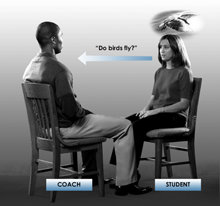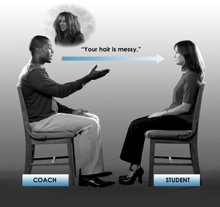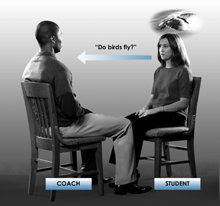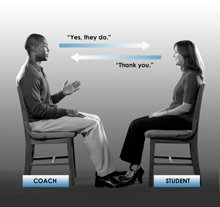Number: TR 3
Name: Getting a Question Answered
Purpose: To acquire the skill of getting a single exact question answered despite diversions.
Have you ever asked a question and not gotten an answer? This can be upsetting, as the communication cycle is incomplete and is left suspended.
In social or other situations, it is important to be able to get your question answered and complete cycles of communication. This drill gives you that ability.
Commands: Either “Do fish swim?” or “Do birds fly?”
Position: Student and coach seated a comfortable distance apart.
Training Stress: One question and student acknowledgment of its answer in one unit of time which is then finished. To keep the student from straying into variations of question.
The student is flunked if he or she fails to get an answer to the question asked, if he or she fails to repeat the exact question, if he or she Q-and-As with excursions taken by the coach.
Each time a question is repeated it exists, theoretically and purely, in its own moment of time and is uttered itself in
When a student is being a machine, simply repeating a question over and over again, there is no intention there. Therefore, when one is repeating a question, it must be expressed in present time as itself with its intention. If a question is always uttered in present time it could be said over and over again without any problem. If a question is repeated over and over with no new intention it becomes
|
TR 3
|
Patter: The coach uses “Start” and “That’s it” as in earlier TRs. The coach is not bound after starting to answer the student’s question, but may give a commenting-type answer that doesn’t really answer the question, in order to throw the student off. Often the coach should answer the actual question asked by the student. Example:
Student: “Do fish swim?”
Coach: “Yes.”
Student: “Good.”
Somewhat less often the coach attempts to pull the student into a Q and A or upset the student. Example:
Student: “Do fish swim?”
Coach: “Aren’t you hungry?”
Student: “Yes.”
Coach: “Flunk.”
When the question is not answered, the student must repeat the question until he gets an answer. Anything except question and acknowledgment is flunked. Unnecessary repeating of the question is flunked. A poor delivery of the question (e.g., lack of intention) is flunked. A poor acknowledgment is flunked. A Q and A is flunked (as in example). Student upset or confusion is flunked. Student failure to utter the next question without a long
A choppy or premature acknowledgment is flunked. Lack of an acknowledgment (or with a distinct communication lag) is flunked. Any words from the coach except an answer to the question, “Start,” “Flunk,” “Good” or “That’s it” should have no influence on the student except to get him to repeat the question again.
“Start,” “Flunk,” “Good” and “That’s it” may not be used to fluster or trap the student. Any other statement under the sun may be. The coach should not use introverted statements such as, “I just had a realization.” “Coach
When the student can consistently get his question answered despite diversions, he has passed this drill.
short for Question and Answer. It means to not get an answer to one’s question, to fail to complete something or to deviate from an intended course of action. Example: Question: “Do birds fly?” Answer: “I don’t like birds.” Question: “Why not?” Answer: “Because they’re dirty.” The original question has not been answered and has been dropped and the person who asked the question has deviated—this is Q and A. The person who deviates could be said to have “Q and Aed.”
the time which is now and which becomes the past almost as rapidly as it is observed. It is a term loosely applied to the environment existing in now.
hard to accomplish; requiring strong effort.
the length of time intervening between the asking of a question and the reply to that specific question by the person asked.
literally, causing a change in the route or path of something. Used figuratively to mean taking somebody’s mind off something and drawing attention to something else.




